![]()
![]()
![]()
Use LEFT and RIGHT arrow keys to navigate between flashcards;
Use UP and DOWN arrow keys to flip the card;
H to show hint;
A reads text to speech;
152 Cards in this Set
- Front
- Back
|
Hyphae
|
Thread-like individual filaments that make up fungi.
|
|
|
Mycelium
|
The body of the fungus that consists of organized hyphae.
|
|
|
What makes up fungi cell walls?
|
Chitin combined with other complex carbohydrates, including cellulose.
|
|
|
In asexual reproduction, certain hyphae grow upright and develop _____, round structures, on their tips. _____ spores develop in the _____ following mitosis, and when they are mature, they are dispersed in the air. If they fall on a suitable medium, they will absorb water and germinate, growing a new _______.
|
Sporangia; haploid; sporangia; mycelium
|
|
|
In sexual mating of Rhizopus, (+) and (-) _____ produce extensions called ____ that fuse forming _____
|
Hyphae; gametangia; zygosporangia
|
|
|
Coprophilous
|
Fungus that grows on dung
|
|
|
Sexual reproduction in the ascomycota fungi produces either 4-8 haploid _____ after meosis in an ascus.
|
Ascospores
|
|
|
Asci form within a structure called an ____.
|
Ascocarp
|
|
|
In ______ reproduction, spores are produced, but rather than being enclosed within a _____ as in a zygote fungi, the spores, called___, are produced on the surface of special reproductive hyphae.
|
Asexual; sporangium; conidia
|
|
|
Budding
|
formation of small cells by pinching off, used in yeast.
|
|
|
Cup Fungi
|
Fungi with ascocarps shaped like a cup.
|
|
|
Morel
|
Cup fungi that resemble mushrooms.
|
|
|
On a basidiocarp, the stalk is the ___, and the cap is the ____.
|
stipe; pileus
|
|
|
Basidia
|
The tips of small club shaped structures where spores are produced in basidiocarps (mushrooms).
|
|
|
Thallus
|
The lichen body.
|
|
|
Fruticose
|
A cylindrical thallus
|
|
|
Define: Phylogenetic Species Concept
|
Species is a basal cluster of organisms that is distinct from other such clusters and shows a pattern of ancestry and descent.
|
|
|
Define: Polyploidy
|
The presence of extra sets of chromosomes due to accidents during cell division.
|
|
|
Define: Autopolyploid
|
An individual with more than 2 chromosome sets, derived from ONE species.
|
|
|
Define: Allopolyploid
|
A species with multiple sets of chromosomes derived from different species.
|
|
|
Define: Allopatric Speciation
|
Speciation resulting from geographic isolation that restricts gene flow between populations.
|
|
|
Define: Sympatric Speciation
|
Speciation resulting from a reproductive barrier.
|
|
|
Green algae called ______ are the closest relatives of land plants.
|
charophytes
|
|
|
What are the 4 key traits that appear in nearly all land plants, but are absent in charophytes?
|
1. Alternation of generations (w/multicellular, dependant embryos)
2. Walled spores produced in sporangia 3. Multicellular gametangia 4. Apical meristems |
|
|
The gametophyte is _____ and produces haploid gametes by ____.
|
haploid; mitosis
|
|
|
Fusion of gametes gives rise to the diploid _____, which produces _____ _____ by meiosis.
|
sporophyte; haploid spores
|
|
|
What are the 3 phyla of small herbaceous (nonwoody) plants belonging to Bryophytes?
|
1. Liverwarts, phylum Hepatophyta
2. Hornworts, phylum anthocerophyta 3. Mosses, phylum Bryophyta |
|
|
What are the 2 phyla of seedless vascular plants?
|
1. Lycophyta - which includes club mosses, spike mosses, and quillworts
2. Pterophyta - ferns, horsetails, and whisk ferns |
|
|
Define: Sporophylls
|
Modified leaves with sporangia.
|
|
|
Define: Sori
|
Clusters of sporangia on the underside of sporophylls.
|
|
|
Define:Strobili
|
Cone-like structures formed from groups of sporophylls.
|
|
|
What are 4 things that are common to all seed plants?
|
Reduced gametophytes, Heterospory, Ovules, and Pollen.
|
|
|
The flower is a(n) _____ structure specialized for sexual reproduction.
|
Angiosperm
|
|
|
What are the 3 basic plant organs?
|
Roots, Stems, and Leaves.
|
|
|
What 3 things do each plant organ have?
|
Dermal, vascular, and ground tissues.
|
|
|
Growth in roots occurs just behind the root tip, in what 3 zones of cells?
|
Zone of: cell division, elongation, and maturation.
|
|
|
Leaves develop from _______ along the sides of the apical meristem.
|
Leaf primordia
|
|
|
The secondary plant body consists of the tissues produced by the _____ and ______.
|
Vascular cambium; cork cambium.
|
|
|
Secondary growth is a characteristic of gymnosperms and many _____, but not _____.
|
Eudicots; monocots.
|
|
|
What are the 3 developmental processes, and what are their purpose?
|
A. Growth, morphogenesis, and cellular differentiation.
B. They act together to transform the fertilized egg into a plant. |
|
|
The vascular cambium is a cylinder of _____ cells one cell layer thick, that is developed from undifferentiated ______ cells.
|
Meristematic; parenchyma.
|
|
|
Define: Morphology
|
Accumulated adapations of external form by natural selection
|
|
|
Taproot systems are composed of one main vertical root called a ____ and branch roots called _____
|
taproot; lateral roots
|
|
|
Point at which leaves attach to steam are called ____. Segment on stem in between each of these are called _____.
|
nodes; internal nodes
|
|
|
In the upper angle formed by each leaf and the stem is called an ________.
|
axillary bud
|
|
|
Common name for lateral shoot
|
branch
|
|
|
Elongation of a young shoot near the shoot tip consists of an ______.
|
apical bud
|
|
|
The inhibition of axillary buds by an apical bud is called _____.
|
apical dominance
|
|
|
Leaves generally consist of a _____ and a _____.
|
blade; petiole (stalk)
|
|
|
Plant tissues:
1. Provides protective cover for the entire body of plant. 2. Transports materials between the root and shoot systems. 3. Reponsible for most of the plants's metabolic functions. |
1. dermal
2. vascular 3. ground |
|
|
The two types of vascular tissues are _____ and _____
|
xylem; phloem
|
|
|
______ conducts water and dissolved minerals upward from the roots into shoots.
|
xylem
|
|
|
______ transport sugars to roots and sites of growth
|
phloem
|
|
|
Plants are capable of indeterminate growth because they have perpetually embryonic tissues called _____.
|
meristems
|
|
|
Two main types of meristems:
1. Define: apical meristems 2. Define: lateral meristems |
1. located at the tips of roots and shoots and in the axillary buds of shoots, provide additional cells that enable the plant to grow in length, a process known as primary growth.
2. growth in thickness, known as secondary growth, attributed to growth in vascular cambium and cork cambium |
|
|
Distinguish the characteristics of algae and seed plants
|
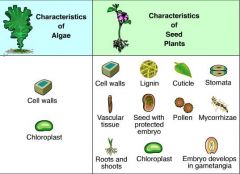
|
|
|
Structures of a bryophyte.
|
|
|
|
Life Cycle of Moss
|

|
|
|
In the life cycle of bryophytes, ______ are the dominant stage and are generally larger than _____. The sporophytes of mosses are made up of a foot, a seta, and a sporangium. The foot is embedded in the gametophyte and absorbs nutrients from it. The seta, or stalk, transports the nutrients to the sporangium, which produces spores. Rhizoids, which resemble the roots of vascular plants, anchor the gametophytes to a substrate. Rhizoids are not vascular structures.
|
gametophytes; sporophytes;
|
|

|

|
|
|
|
|
|
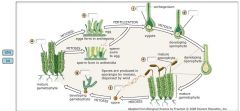
|

|
|
|
What are the 3 categories in which land plants are classified?
|
Seed plants, Nonvascular plants, Seedless vascular plants.
|
|
|
Phylogentic Tree of Plants
|
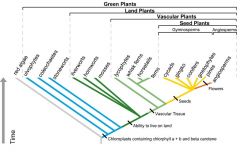
|
|
|
Phylogentic Tree of Plants
|

|
|
|
A _____ is a membrane-bound compartment inside chloroplasts and cyanobacteria.
|
thylakoid
|
|
|
What is a cuticle?
|
Cuticle is a waxy coating that allows plant cells to retain water; evidence of cuticle is seen in the plant fossil record from about 475 million years ago, which has led scientists to deduce that plants moved onto land at this time.
|
|
|
Moss life cycle
|
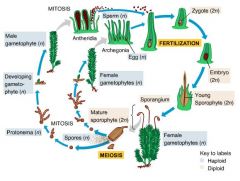
|
|
|
A ____ is a membrane-bound compartment inside chloroplasts and cyanobacteria
|
thylakoid
|
|
|
n mosses gametes are produced by _____; in ferns gametes are produced by _____.
|
mitosis, mitosis
|
|
|
Fern lifecycle.
|
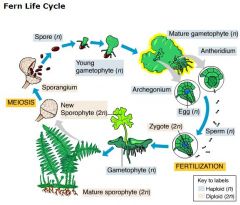
|
|
|
Where do haploid antheridia in ferns develop?
|
The underside of mature haploid gametophytes.
|
|
|
The conspicuous part of a fern plant is a _____.
|
diploid sporophyte
|
|
|
In _______, seeds are enclosed in an ovary. In _________, seeds are not enclosed in an ovary.
|
angiosperms; gymnosperms
|
|

|

|
|
|
Gymnosperms (literally "naked seeds") are _____ plants that produce seeds that are not enclosed in an ovary.
|
vascular
|
|
|
In gymnosperms, the ____ is the dominant form of the life cycle.
|

sporophyte
|
|
|
|
|
|
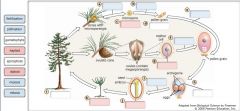
|

|
|
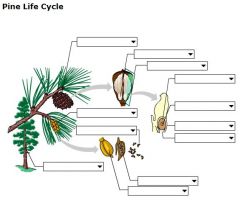
|

|
|
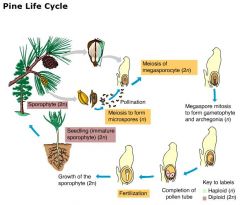
|
.
|
|
|
In pines, the female gametophyte contains _____, each of which contains a(n) _____.
|
Archegonia; egg
|
|
|
In pines, an embryo is a(n) _____.
|
immature sporophyte
|
|
|
What surrounds the megasporangium?
|
Integuments
|
|
|
Of the four haploid cells produced by a pine cone's megasporocyte (megaspore mother cell), _____ survive(s).
|
1
|
|
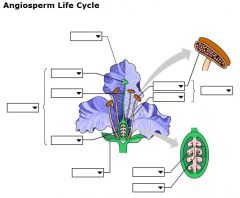
|

|
|
|
The pollen tube enters the ovary and releases the two sperm nuclei into the embryo sac. One sperm nucleus fertilizes the egg, forming a diploid zygote. The other sperm nucleus fuses with two nuclei in the center of the ovule to form a triploid (3n) cell that will develop into a nutritive tissue called ______.
|
endosperm
|
|
|
What are cotyledons?
|
Seed leaves.
|
|
|
Angiosperm lifecycle
|
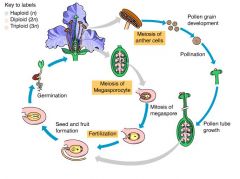
|
|
|
What is unique to flowering plants?
|
Double fertilization
|
|
|
The male gametophytes of flowering plants are also referred to as _____
|
pollen grains
|
|
|
In flowering plants the integuments of the ovule develop into a(n) _____.
|
Seed coat
|
|
|
In flowering plants one megaspore gives rise to _____ nuclei.
|
eight haploid
|
|
|
Water is moving up the tree as it ______ from the leaf surface.
|
evaporates
|
|
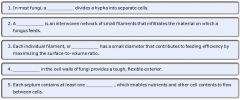
|

|
|
|
Some hyphae, called ____ hyphae, are divided into cells by crosswalls, or _____.
|
septate; septa
|
|
|
_____ hyphae do not have septa; these hyphae consist of a continuous cytoplasmic mass that contains many nuclei and organelles.
|
Coenocytic
|
|
|
Nutrients absorbed by the hyphae of fungi can flow throughout the mycelium in both ____________ and __________.
|
Coenocytic hyphae and septate hyphae.
|
|
|
Some of the hyphae in the gills of mushrooms develop into larger, club-shaped cells called ____. Each _____ undergoes meiosis and produces spores.
|
basidia; basidium
|
|
|
Fungal life cycle
|
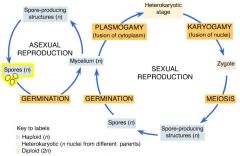
|
|
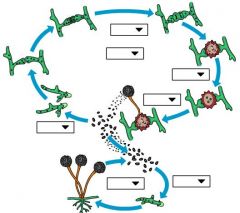
The life cycle of a black bread mold, a representative of phylum Zygomycota, the zygote fungi.
|

|
|
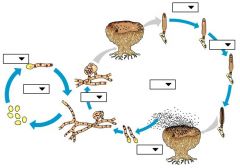
The life cycle of a cup fungus, a representative of phylum Ascomycota, the sac fungi.
|

|
|
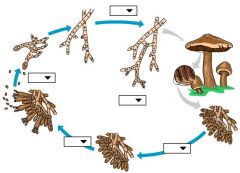
The life cycle of a mushroom, representing phylum Basidiomycota, the club fungi.
|

|
|
|
Karyogamy produces a _____.
|
diploid zygote
|
|
|
The heterokaryotic stage is produced by _______.
|
plasmogamy
|
|
|
Zygosporangia are _____.
|
heterokaryotic
|
|
|
Karyogamy and meiosis in asci produce ______.
|
ascospores
|
|
|
In club fungi, karyogamy and meiosis occur in _____.
|
basidia
|
|
|
In most fungi, fertilization is a two-step process consisting of the fusion of ___ and then the fusion of nuclei in the ____.
|
cells; fused cells
|
|
|
A mushroom consists mainly of hyphae that are _______, which means they have two distinct haploid nuclei per cell; these nuclei may fuse in specialized cells called ______ and become diploid in preparation for meiosis and spore production.
|
heterokaryotic; basidia
|
|
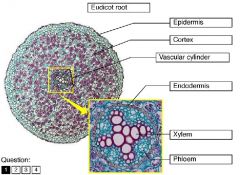
|
.
|
|
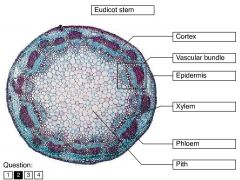
|
.
|
|
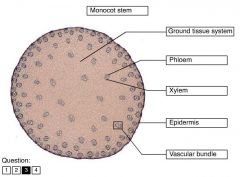
|
.
|
|

|
.
|
|
|
Where are chloroplasts found at in leaves?
|
The palisade and spongy mesophyll.
|
|
|
What do gaurd cells in leaves do?
|
Regulate the opening and closing of stomata.
|
|
|
________ plants experience only primary growth. They have a primary plant body that consists of tissues produced by the apical meristems.
|
Herbaceous (nonwoody)
|
|
|
_____ plants generally undergo extensive primary growth and therefore require more structural support, which is provided by secondary growth. The secondary plant body consists of tissues produced by two types of lateral meristem: the vascular cambium and the cork cambium.
|
Woody
|
|
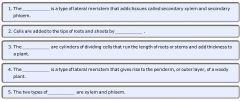
|

|
|
|
The ________ adds layers, or rings, of secondary xylem and phloem. The ______ produces the thick, protective covering of woody plants, called periderm.
|
vascular cambium; cork cambium
|
|
|
Primary growth in roots occurs in what three zones?
|
The zone of cell division, the zone of elongation, and the zone of differentiation (zone of maturation).
|
|
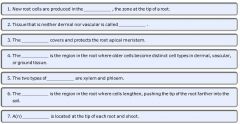
|

|
|
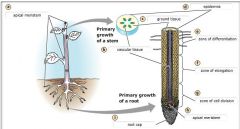
|
.
|
|
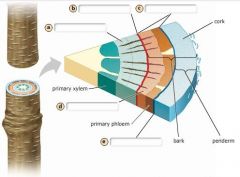
|

|
|
|
The youngest vascular tissues are those located nearest the ______.
|
Vascular cambium.
|
|
|
What makes up bark?
|
Phloem (secondary & primary) and Periderm (cork cambium & cork).
|
|
|
Secondary growth never occurs in ___.
|
leaves
|
|
|
Which lateral meristem provides cells for secondary growth?
|
Vascular cambium.
|
|
|
What is the function of cork?
|
insulation and waterproofing
|
|
|
Secondary xylem and phloem are produced by the differentiation of __________.
|
vascular cambium
|
|
|
What happens when a vascular cambium cell divides?
|
1 cell differentiates and the other cell remains meristematic.
|
|

|

|
|
|
The embryogenesis of a plant zygote in a seed.
|

|
|
|
Floral meristems are modified ________.
|
shoot apical meristems
|
|
|
Wild flower mutations.
|
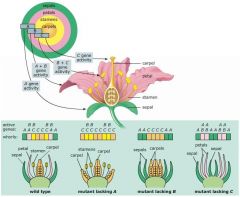
|
|
|
________ in leaves generates the force that pulls water through the xylem. ______ between water molecules in leaves, stems, and roots transmits that force. ____ of water to plant cell walls in leaves and stems opposes the force of gravity, which tends to pull water downward in the xylem.
|
Surface tension; Cohesion; Adhesion
|
|
|
Structure of veins in leaves.
|

|
|
|
The cell types in a leaf.
|
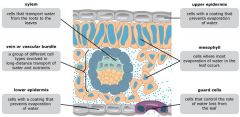
|
|
|
Where does water transport occur in the xylem?
|
The apoplast.
|
|
|
What do plasmodesmata do?
|
They are cell junctions that allow water and ions to pass from cell to cell.
|
|
|
The ____ is a cytoplasmic continuum through which water and ions can traverse a root.
|
symplast
|
|
|
Mycorrhizae are mutualistic associations of _____and _____.
|
Roots and fungi.
|
|
|
In roots the _____ forces water and solutes to pass through the plasma membranes of _____ cells before entering the _____.
|
Casparian strip; endodermis; xylem.
|
|
|
Which tissue acts as a filter on the water absorbed by root hairs?
|
endodermis
|
|
|
Root pressure can move water a ___ distance up the xylem because of the ____ water potential of the xylem in comparison to the water potential in the surrounding cells.
|
short; lower
|
|
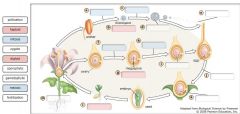
|

|
|
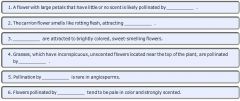
|

|
|
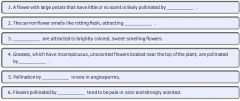
|

|
|
|
Contrasting nonvascular plants and Angiosperms
|

|
|
|
The union of the cytoplasms of two parent mycelia is known as _______.
|
Plasmogamy
|
|
|
Plasmogamy produces a sturdy structure called a _______.
|
Zygosporangium
|
|
|
In fungi, the fusion of haploid nuclei to produce a diploid cell is called ______.
|
Karyogamy
|

